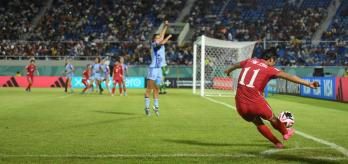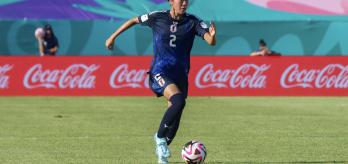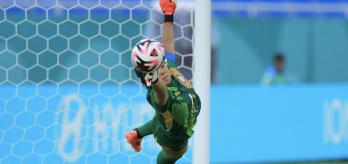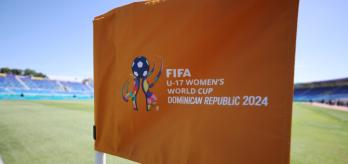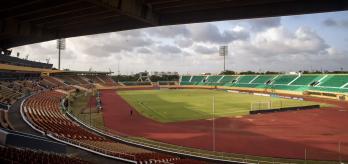Tactically, Spain’s clever and consistent rotational patterns, combined with the technical competence of their players, meant they could create overloads and break the lines of the USA’s well-organised defensive structure.
As TSG member Vanessa Bernauer notes, “When building their play, Spain used distinct rotations with a distinct purpose on both sides of the pitch. Players were clear in their understanding of their roles and in the reasoning behind the movements they were making. They knew when to keep the ball or to risk the forward pass, as well as when to go forward or to go wide. It was very clear that the Spanish players understood the scenarios they were trying to create and kept the ball until they could find those situations.
“To see this level of tactical awareness in players at U-17 level was eye-catching. I also found it very impressive to see how technically competent they were and the good habits they consistently demonstrated when moving to receive, receiving the ball and playing the next pass. Their positional awareness, scanning, body shape when receiving and range of passing was something we have not really seen at this age group before,” she explained.
Spain’s movement pattern in the build-up phase
These rotations occurred on both sides of the pitch and were triggered as Spain’s centre-backs switched play in the build-up phase. They frequently occurred between the full-back, advanced centre-midfielders and winger on that side with the patterns also being used when building from their goalkeeper.
The full-backs would either push high and allow the winger to come inside, while the advanced midfielder made runs into wide areas, or sometimes the full-back inverted into midfield allowing the winger or advanced midfielder to receive out wide.
As can be seen in clip 1 below, Spain were patient in the build-up and did not attempt to play forward unless they felt they had a player available who could successfully receive and retain the ball. The movements, once initiated, were really co-ordinated with all players involved in the rotation operating with synergy and good timing.
Bernauer states that, “As the centre-backs and goalkeeper switch play, it is clear they are trying to draw the USA’s press forward to open space between their lines. The two USA forwards tried to position themselves quite narrow to prevent passes into centre-midfielder Irune Dorado (11) so the movements in the wide areas are designed to move the opposition’s defending players and create gaps in structure.
“Spain don’t play forward unless the picture they want is available. The rotation happens on the left, but they don’t play to it, then it happens on the right, and they play to it, achieving the 2v1. Their players are constantly scanning the pitch to see where the space is and to know where pressure might come from if they receive the ball. As soon as they recognise that it is not favourable to play forward, their focus switches to retaining possession and they start their build-up again. Spain's players are constantly moving ahead of the ball but there is genuine purpose to those movements,” she added.
In clip 2, we see an example of the deliberate movements and the clear intent in them. As the play builds, Spain’s left-back, Aiara Agirrezabala (12), moves inside to open space for the left centre-back, Amaya García (5), to drive forward with the ball. As she does, left winger Pau Comendador (10) drops down, dragging the USA’s right-back with her, before checking back to run into the space left vacated. This is clearly an intentional movement with a desired effect.
Tactical Awareness: Understanding triggers and space
Spain’s players were very aware of their surroundings and understood the triggers to initiate their movements. Their tactical control demonstrated great maturity in their decision-making as they constantly moved to create 2v1 overloads ahead of the player in possession of the ball. These movements and offers to receive were very high during the build-up, with Spain making 163 offers in this phase compared to the USA’s 55. The volume of ball receptions in this phase during this game was exceptionally high with Spain registering 292 compared to just 63 for their opponents. This data strongly reinforces how hard Spain’s players worked in the build-up phase when operating against a well-organised USA defence.
Interestingly, (as shown in the second graphic below) many of Spain’s players received the ball under no pressure, with their right winger, Celia Segura (9), right-back Martina González (2), left winger Pau Comendador (10) and attacking midfielder Ainoa Gómez (8) all ranked in the top four in the match for percentage of ball receptions under no pressure.
As Bernauer explains, “Players were always scanning and knew where they were expected to be, but also knew where other players should be. Every pass triggered new movements, not just ahead of the ball, but forward runs behind the player in possession also created overloads ahead of the ball. The reason for so many receptions occurring under no pressure is that Spain’s players were so good at moving to get between the lines and create overloads, meaning that the USA defenders could not mark both players in their vicinity.
“I really liked Spain’s centre-midfielder, Irune Dorado (11). She was very calm on the ball, knew when to take risks and when to slow it down. Her ability to control the game with the quality and accuracy of her passing was a key component of how Spain dictated and changed the tempo of the game. Because their players were comfortable using both feet, when they decided to play forward, they could do it with minimal touches and this gave them real attacking momentum.”
In clip 3 below, we see an example of how Spain created a 2v1 situation ahead of the player in possession, with every pass and reception of the ball triggering new movements, while we also see players scanning the pitch and using both feet when interacting with the ball.
Technical attributes
It was clear that Spain had worked on these rotations and patterns in training, and this contributed to their effectiveness. However, the technical competencies and habits of their players should not be underestimated when considering the successes. Here, Bernauer highlights some of the technical qualities on display.
Scanning
Spain’s players were constantly scanning and checking over their shoulders before they received the ball. They knew where pressure was coming from and where they wanted to play the ball before they received it. For such a young team, they were so good at this and there are many players at senior level that don’t do this.
Body shape when receiving
Because of their positional awareness, they knew where the space was, and they were clever in how they used their bodies to protect the ball and evade pressure. Since they already knew what they wanted to do next before they received the ball, the players could receive with a body shape that opened up the part of the pitch they wanted to play into. Crucially, the player passing the ball was very good at reading the body shape of the receiver and playing sympathetic passes with the right weight and trajectory to facilitate a positive first touch.
Ball control and the first touch
Their players were competent at shifting the ball from one foot to the other and in using different parts of their feet to move the ball. This meant that regardless of which foot they preferred, they could receive with one, using their first touch to shift into space or move away from pressure, before playing the ball with the other. This helped them to generate real speed and momentum as they progressed the ball forward.
Execution of pass
The quality and range of passing by Spain’s players was also very impressive. Technically, they proved very capable of playing passes over different distances and with the correct weight and pace. Often in teams, you might see two or three players that can play passes at a high level technically. However, the whole team could do it.
As a team, Spain completed 85% of their passes in this game (the USA completed 68%) and they retained the ball in 73% of those receptions. Due to Spain’s desire to retain possession, it is clear that some of those passes could be deemed low risk. Nevertheless, they also generated impressive completion rates for their forward passes, registering a 79% success rate compared to the USA’s 60%. As shown in the graphic below, seven of Spain’s players were in the top 10 for the proportion of forward passes completed.
In clip 4 below, we see some great examples of Spain’s players displaying these techniques. Movements to receive, scanning, body shape to progress the ball and evade pressure, competence on the ball with both feet and passing accuracy are all evident as they progress the ball from their build-up phase into the final third.
Finally, in clip 5, we see great example of how Pau Comendador (10) scans before receiving from a throw-in. The quick passing and supporting movements show how quickly Spain could move the ball and create a goalscoring opportunity.
Key take-aways
The technical competency and good habits of Spain’s players were a key contributing factor in the execution of their tactical game plan.
- Scanning to recognise space and expected pressure
- Movements to receive in relation to the movements and positions of players around them to create overloads
- Body shape to evade pressure and knowing where they wanted to play to next
- Using both feet to create space and generate speed in their passing






